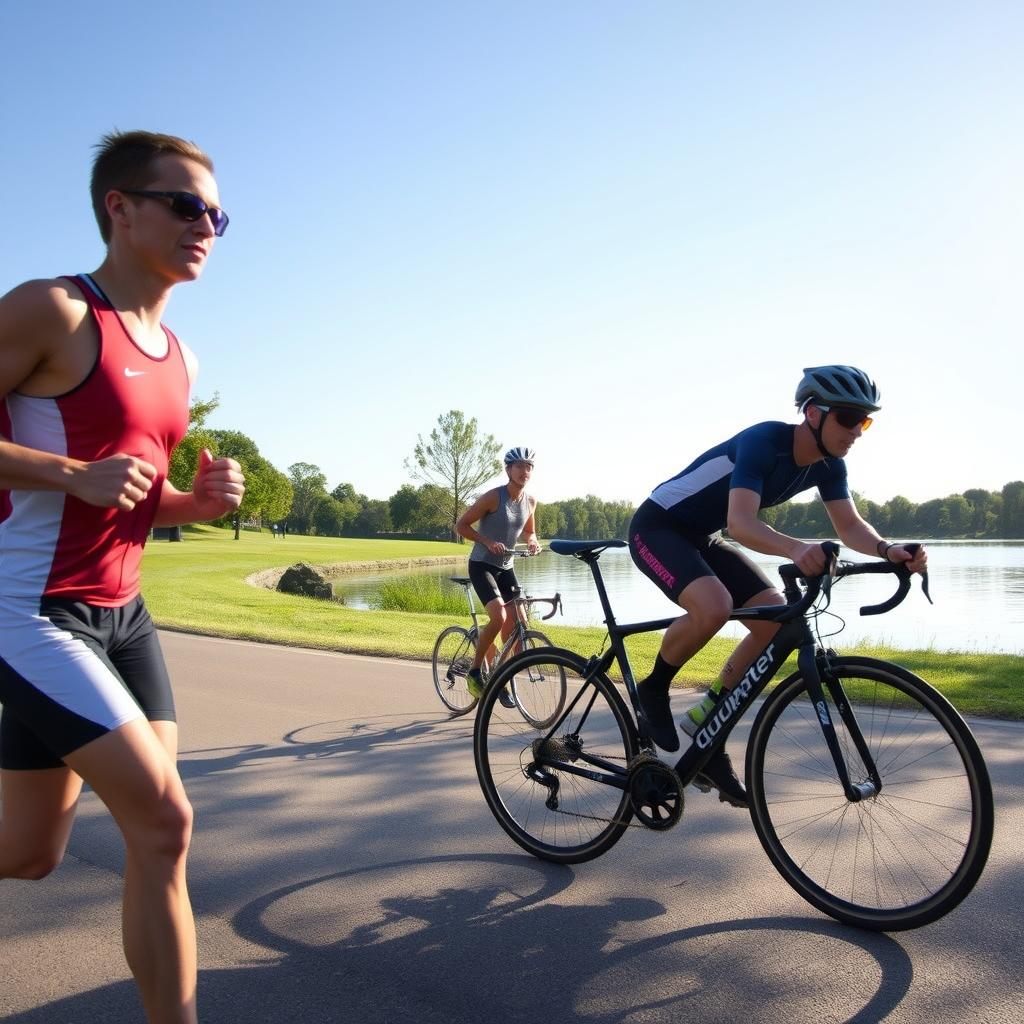Preparing for a Half Ironman also called Ironman 70.3 is no small feat, but with the right training plan, it’s absolutely achievable. The race consists of:
- Swim: 1.2 miles (1.9 km) in open water
- Bike: 56 miles (90 km) of cycling
- Run: 13.1 miles (21.1 km), the distance of a half marathon
If you’re a beginner looking to cross the finish line for the first time or an intermediate athlete seeking to hit a personal best, a Half Ironman training plan is critical. Why? It ensures your workouts sets are structured, manageable, and designed to avoid burnout especially if you’re balancing training with work or family commitments.
Wondering if this plan is for you? If you’re ready to focus on swim technique, build bike endurance, and improve running stamina while staying race day ready, then this plan has you covered. Remember, success comes from preparation, not just motivation!
Understanding the Basics of Half Ironman Training
Training for a Half Ironman is an exciting journey, but it all begins with understanding the core disciplines: swim, bike, and run. Each leg of the race requires unique preparation, and balancing these components is key to a successful performance.
1. The Three Disciplines Explained
Swimming: For many, this is the most daunting part. Focus on swim efficiency by working on your technique and incorporating drills to refine your stroke. Pool sessions and open water swims build both skill and confidence.
Cycling: The bike portion makes up the largest chunk of the race. Prioritize endurance rides and experiment with cadence, aiming for a consistent RPM that feels sustainable over long distances.
Running: The final stretch! Improving stamina and running off the bike (known as “brick workouts”) is crucial to ensure your legs adapt to the swift transition between disciplines.
2. Why Brick Workouts Matter
Brick workouts simulate race day transitions by combining two activities, typically cycling followed by running. These sessions condition your body to handle the fatigue of switching disciplines, sharpening both your endurance and mental resilience. Start with shorter intervals and gradually increase the intensity to build confidence in your transitions.
3. Rest and Recovery: The Secret Sauce
Did you know that your rest days are just as important as your workouts? Skipping recovery can lead to burnout or injuries, derailing your progress. Strategic rest days within your Half Ironman training plan allow muscles to repair and strengthen, improving overall performance. Incorporate activities like stretching or light yoga to enhance recovery without overloading your body.
By focusing on these core elements efficient swimming, steady cycling, confident running, and proper recovery you’ll lay the foundation for a successful race. Ready to take on the challenge?
Training Plan Overview Beginners vs. Intermediates

Beginner plans often prioritize gradual progression, shorter workouts, and more recovery days to prevent burnout. Intermediate plans, by contrast, incorporate brick sessions, race-specific pacing goals, and strategies to improve weak areas. Both options emphasize realistic goal-setting because let’s face it, diving into an overly ambitious plan can lead to frustration or injury. How many weeks can you commit to training?
| Experience Level | Main Focus | Typical Duration | Key Features |
|---|---|---|---|
| Beginner | Building endurance, skill fundamentals | 8-12 weeks | Frequent rest days, manageable intensity |
| Intermediate | Improving race pace, tackling limiters | 12-20 weeks | Brick workouts, pacing drills, advanced intervals |
Choosing the right plan also hinges on time and lifestyle management. Beginners often balance triathlon prep with demanding schedules, while intermediates usually fine-tune training around work, family, or other commitments. So, ask yourself: what’s realistic for me? From 8-week crash courses to 20-week detailed regimens, there’s a plan suited to every goal and experience level. Pick one that aligns with your fitness journey!
Tips for Managing Training with a Busy Schedule
We get it balancing a Half Ironman training plan with a demanding work schedule, family commitments, or social life can feel overwhelming. But with the right strategies, like following a structured 1700 Calorie Meal Planto support your energy and recovery, you can optimize your workout experience, train smart (not just hard), and make consistent progress even on tight timelines.

Prioritize the Key Workouts
Not all training sessions are created equal. Focus on the sessions that build the foundation for race day, such as long bike rides, swim drills, and brick workouts (bike to run transitions). These workouts mimic race conditions and are crucial for building endurance and confidence. When time is limited, don’t skip these!
Incorporate Flexible Scheduling
Life doesn’t always cooperate with your training plan, so flexibility is key. Can’t fit in a two hour ride after work? Consider splitting your session an hour ride in the morning and a shorter spin later. Use weekends to tackle longer workouts when you have more downtime.
Maximize Short Sessions
- Interval Workouts: These are perfect for quick runs or rides. They help improve speed and cardio fitness in a fraction of the time.
- Swim Technique Drills: Spend 30 minutes improving your efficiency in the water. Small gains here can lead to big race day improvements.
- Strength Training: A 20 minute power session at home can enhance overall performance and injury prevention.
Ultimately, it’s about consistency. Even if you can’t follow your plan perfectly, focus on doing something each week that keeps you progressing toward your goal. A little creativity and flexibility can take you far not just to the start line, but across the finish line.
Tools and Tips to Keep Improving Over Time
Embarking on your Half Ironman journey requires more than just a training routine it’s about consistent growth, smart tracking, and finding your community. Thankfully, with the right tools and resources, progress becomes more manageable and engaging. Let’s explore how you can elevate your training experience.
Get the Perfect Training Plan
Whether you’re a beginner looking to cross the finish line or an intermediate athlete chasing a personal best, having a structured plan is essential. Look for downloadable and customizable Half Ironman training plans that suit your level and schedule. Free plans often come with flexible durations (like 12 or 20 weeks) and key features like rest days and brick workouts. These plans aren’t just PDFs they’re roadmaps tailored for success.
Track Workouts Like a Pro
Tracking your progress isn’t just motivating it’s the foundation for improvement. Here are some top tools and apps to consider:
- TrainingPeaks: Offers detailed analytics for tracking swim, bike, and run data.
- MyFitnessPal: Helps ensure your nutrition aligns with your Half Ironman goals.
- Garmin Connect: Syncs seamlessly with wearables for live feedback during workouts.
Join a Like Minded Community
Training solo can be tough, but connecting with others changes the game. Join online forums or Facebook groups dedicated to Half Ironman athletes for motivation, advice, and camaraderie. These communities aren’t just spaces to ask questions they’re where shared triumphs make the journey even more rewarding.
Final Thoughts on Your Half Ironman Journey

Hardik is the visionary founder and driving force behind Leanry.com, a platform committed to empowering individuals through reliable health information, wellness tips, and actionable content for a healthier lifestyle.

